Developing an Advanced PVT System for Sustainable Domestic Hot Water Supply
Abstract
:1. Introduction
2. System Description
3. Mathematical Modeling
3.1. Thermal Modeling and Thermal Efficiency
3.2. Electrical Modeling and Electrical Efficiency
3.3. Fluid Modeling and Computational Fluid Dynamics (CFD)
Mesh and Boundary Conditions
4. Results and Discussion
4.1. System Validation
4.2. Domestic Hot Water Production by Solar Heat
4.2.1. Parametric System Analysis
4.2.2. Thermal Efficiency Variations
4.2.3. Electrical Efficiency Variations
4.3. Electricity Production and Further Increase of Water Temperature by Electricity
5. Conclusions
- The evacuated PVT system showed the highest thermal performance and flexibility compared to the other systems. This system can reach the thermal efficiency of 64–67% at different solar irradiances and water mass flow rates for DHW supply.
- Interestingly, encapsulating the PVT system did not decrease the electrical efficiency of the system. The evacuated PVT can operate at higher mass flow rates of water, which leads to higher heat removal from the bottom of the PV. The electrical efficiency of the evacuated PVT was measured between 14.2–16.7%.
- The unglazed system showed poor performance at higher outlet water temperature or low solar irradiance. However, this system has a good performance at higher mass flow rates (i.e., lower outlet water temperature), which makes this system a good choice for preheating water. At a solar irradiance of 800 W/m2, the unglazed system can reach to an outlet temperature of 40.06 °C with a thermal efficiency of 63.10%, while at an outlet temperature of 56.16 °C, the thermal efficiency is only 28.98%.
- The glazed system has slightly better performance than the unglazed system only at higher outlet water temperatures, but much lower than the evacuated system. At lower outlet temperatures, it showed the lowest thermal performance. In general, this system does not have a significant advantage over the unglazed system.
- The application of heat pumps can significantly decrease the dependency of the backup system on the electrical grid. Coupling a high-performance PVT system with a heat pump is a promising idea for sustainable DHW production. The heat pump with COP of 5 coupled with an evacuated PVT system could supply the required water temperature with minimum dependency on the grid. This combination can reduce the required external power up to 620 W/m2.
Author Contributions
Funding
Institutional Review Board Statement
Informed Consent Statement
Data Availability Statement
Conflicts of Interest
Nomenclature
| a | ambient | |
| A | area (m2) | |
| c | specific heat (J/kg.K) | |
| conv | convection | |
| COP | coefficient of performance | |
| D | hydraulic diameter (m) | |
| e | electrical | |
| E | energy (kJ) | |
| EH | electrical heater | |
| g | gravity (m/s2) | |
| h | enthalpy (kJ/kg) | |
| HP | heat pump | |
| I | solar irradiance (W/m2) | |
| k | thermal conductivity (W/m.K) | |
| m | mean | |
| Nu | Nusselt number | |
| p | pressure (kPa) | |
| Q | heat (kJ) | |
| rad | radiation | |
| Re | Reynolds number | |
| ref | references | |
| T | temperature (K) | |
| u, v, w | velocity in x, y, z (m/s) | |
| x, y, z | spatial coordinates | |
| α | absorptivity | |
| β | thermal coefficient (K−1) | |
| ε | emissivity | |
| τ | transmissivity | |
| η | efficiency | |
| density (kg/m3) | ||
| µ | viscosity (N.s/m2) | |
| σ | Stephan–Boltzmann constant (W/m2.K4) |
References
- BP p.l.c. Statistical Review of World Energy 2021, Bp. 2021. Available online: https://www.bp.com/en/global/corporate/energy-economics/statistical-review-of-world-energy.html (accessed on 25 January 2022).
- DNV. The Impact of Covid-19 on the Energy Transition. 2020. Available online: www.dnv.com (accessed on 25 January 2022).
- BP p.l.c. Statistical Review of World Energy 2019, Bp. 2019. Available online: https://www.bp.com/en/global/corporate/news-and-insights/press-releases/bp-statistical-review-of-world-energy-2019.html (accessed on 25 January 2022).
- Zouaoui, A.; Zili-Ghedira, L.; Nasrallah, S.B. Open solid desiccant cooling air systems: A review and comparative study. Renew. Sustain. Energy Rev. 2016, 54, 889–917. [Google Scholar] [CrossRef]
- el Hourani, M.; Ghali, K.; Ghaddar, N. Effective desiccant dehumidification system with two-stage evaporative cooling for hot and humid climates. Energy Build. 2014, 68, 329–338. [Google Scholar] [CrossRef]
- Pomianowski, M.Z.; Johra, H.; Marszal-Pomianowska, A.; Zhang, C. Sustainable and energy-efficient domestic hot water systems: A review. Renew. Sustain. Energy Rev. 2020, 128, 109900. [Google Scholar] [CrossRef]
- Köfinger, M.; Basciotti, D.; Schmidt, R.R.; Meissner, E.; Doczekal, C.; Giovannini, A. Low temperature district heating in Austria: Energetic, ecologic and economic comparison of four case studies. Energy 2016, 110, 95–104. [Google Scholar] [CrossRef]
- An, J.; Yan, D.; Deng, G.; Yu, R. Survey and performance analysis of centralized domestic hot water system in China. Energy Build. 2016, 133, 321–334. [Google Scholar] [CrossRef]
- Boait, P.J.; Dixon, D.; Fan, D.; Stafford, A. Production efficiency of hot water for domestic use. Energy Build. 2012, 54, 160–168. [Google Scholar] [CrossRef]
- Biaou, A.L.; Bernier, M.A. Achieving total domestic hot water production with renewable energy. Build. Environ. 2008, 43, 651–660. [Google Scholar] [CrossRef]
- Rommel, M.; Zenhäusern, D.; Baggenstos, A.; Türk, O.; Brunold, S. Application of unglazed PVT collectors for domestic hot water pre-heating in a development and testing system. Energy Procedia 2014, 48, 638–644. [Google Scholar] [CrossRef] [Green Version]
- Gunerhan, H.; Hepbasli, A. Exergetic modeling and performance evaluation of solar water heating systems for building applications. Energy Build. 2007, 39, 509–516. [Google Scholar] [CrossRef]
- Martorana, F.; Bonomolo, M.; Leone, G.; Monteleone, F.; Zizzo, G.; Beccali, M. Solar-assisted heat pumps systems for domestic hot water production in small energy communities. Sol. Energy 2021, 217, 113–133. [Google Scholar] [CrossRef]
- Huang, B.J.; Lee, C.P. Performance evaluation method of solar-assisted heat pump water heater. Appl. Therm. Eng. 2007, 27, 568–575. [Google Scholar] [CrossRef]
- Dannemand, M.; Perers, B.; Furbo, S. Performance of a demonstration solar PVT assisted heat pump system with cold buffer storage and domestic hot water storage tanks. Energy Build. 2019, 188–189, 46–57. [Google Scholar] [CrossRef]
- Douvi, E.; Pagkalos, C.; Dogkas, G.; Koukou, M.K.; Stathopoulos, V.N.; Caouris, Y.; Vrachopoulos, M.G. Phase change materials in solar domestic hot water systems: A review. Int. J. Thermofluids 2021, 10, 100075. [Google Scholar] [CrossRef]
- Joshi, S.S.; Dhoble, A.S. Photovoltaic -Thermal systems (PVT): Technology review and future trends. Renew. Sustain. Energy Rev. 2018, 92, 848–882. [Google Scholar] [CrossRef]
- Hamzat, A.K.; Sahin, A.Z.; Omisanya, M.I.; Alhems, L.M. Advances in PV and PVT cooling technologies: A review. Sustain. Energy Technol. Assess. 2020, 47, 101360. [Google Scholar] [CrossRef]
- Emmanuel, B.; Yuan, Y.; Maxime, B.; Gaudence, N.; Zhou, J. A review on the influence of the components on the performance of PVT modules. Sol. Energy 2021, 226, 365–388. [Google Scholar] [CrossRef]
- Dupeyrat, P.; Ménézo, C.; Fortuin, S. Study of the thermal and electrical performances of PVT solar hot water system. Energy Build. 2014, 68, 751–755. [Google Scholar] [CrossRef]
- Yuan, Y.; Ouyang, L.; Sun, L.; Cao, X.; Xiang, B.; Zhang, X. Effect of connection mode and mass flux on the energy output of a PVT hot water system. Sol. Energy 2017, 158, 285–294. [Google Scholar] [CrossRef]
- Nasrin, R.; Rahim, N.A.; Fayaz, H.; Hasanuzzaman, M. Water/MWCNT nanofluid based cooling system of PVT: Experimental and numerical research. Renew. Energy 2018, 121, 286–300. [Google Scholar] [CrossRef]
- Carmona, M.; Bastos, A.P.; García, J.D. Experimental evaluation of a hybrid photovoltaic and thermal solar energy collector with integrated phase change material (PVT-PCM) in comparison with a traditional photovoltaic (PV) module. Renew. Energy 2021, 172, 680–696. [Google Scholar] [CrossRef]
- Brottier, L.; Bennacer, R. Thermal performance analysis of 28 PVT solar domestic hot water installations in Western Europe. Renew. Energy 2020, 160, 196–210. [Google Scholar] [CrossRef]
- Evacuated Tube Collector. Available online: https://www.alternative-energy-tutorials.com (accessed on 25 January 2022).
- Duan, J. A novel heat sink for cooling concentrator photovoltaic system using PCM-porous system. Appl. Therm. Eng. 2021, 186, 116522. [Google Scholar] [CrossRef]
- Rodríguez-Hidalgo, M.C.; Rodríguez-Aumente, P.A.; Lecuona, A.; Legrand, M.; Ventas, R. Domestic hot water consumption vs. solar thermal energy storage: The optimum size of the storage tank. Appl. Energy 2012, 97, 897–906. [Google Scholar] [CrossRef] [Green Version]
- Yang, L.W.; Xu, R.J.; Hua, N.; Xia, Y.; Zhou, W.B.; Yang, T.; Belyayev, Y.; Wang, H.S. Review of the advances in solar-assisted air source heat pumps for the domestic sector. Energy Convers. Manag. 2021, 247, 114710. [Google Scholar] [CrossRef]
- Pawar, V.R.; Sobhansarbandi, S. CFD modeling of a thermal energy storage based heat pipe evacuated tube solar collector. J. Energy Storage 2020, 30, 101528. [Google Scholar] [CrossRef]
- Santbergen, R. Optical Absorption Factor of Solar Cells for PVT Systems; Technische Universiteit Eindhoven: Eindhoven, The Netherlands, 2008; Volume 176. [Google Scholar] [CrossRef]
- Nasrin, R.; Hasanuzzaman, M.; Rahim, N.A. Effect of high irradiation and cooling on power, energy and performance of a PVT system. Renew. Energy 2018, 116, 552–569. [Google Scholar] [CrossRef]
- Kumar, A.V.; Arjunan, T.V.; Seenivasan, D.; Venkatramanan, R.; Vijayan, S. Thermal performance of an evacuated tube solar collector with inserted baffles for air heating applications. Sol. Energy 2021, 215, 131–143. [Google Scholar] [CrossRef]
- Rosli, M.A.M.; Sopian, K.; Mat, S.B.; Sulaiman, M.Y.; Salleh, E. Heat Removal Factor of an Unglazed Photovoltaic Thermal Collector with a Serpentine Tube; Springer: Cham, Switzerland, 2016. [Google Scholar]
- Dubey, S.; Sarvaiya, J.N.; Seshadri, B. Temperature dependent photovoltaic (PV) efficiency and its effect on PV production in the world—A review. Energy Procedia 2013, 33, 311–321. [Google Scholar] [CrossRef] [Green Version]
- Hudisteanu, S.; Mateescu, T.; Popovici, C.; Chereces, N.-C. Numerical study of air cooling photovoltaic panels using heat sinks. Rev. Romana Ing. Civ. 2015, 6, 11–21. [Google Scholar]

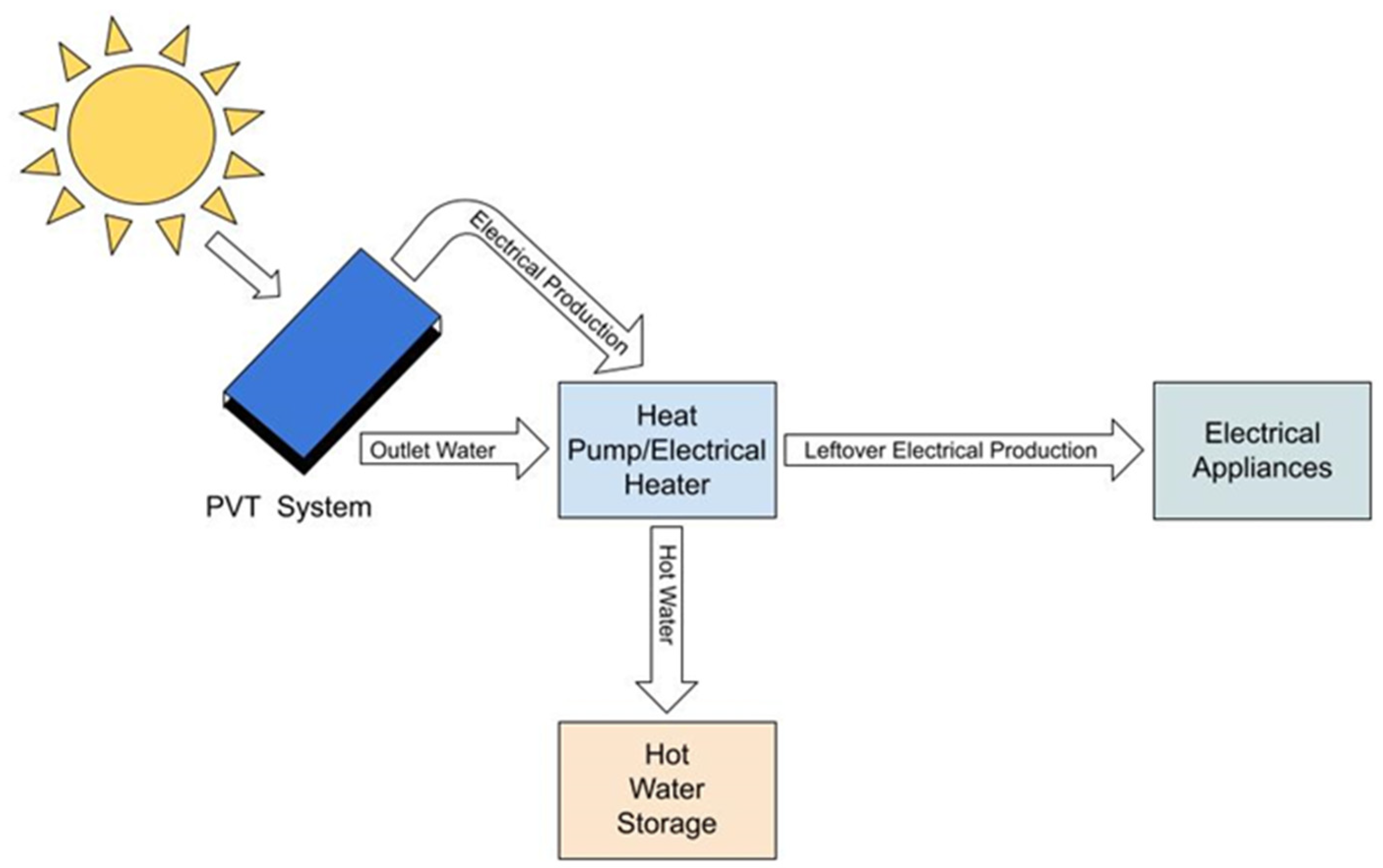

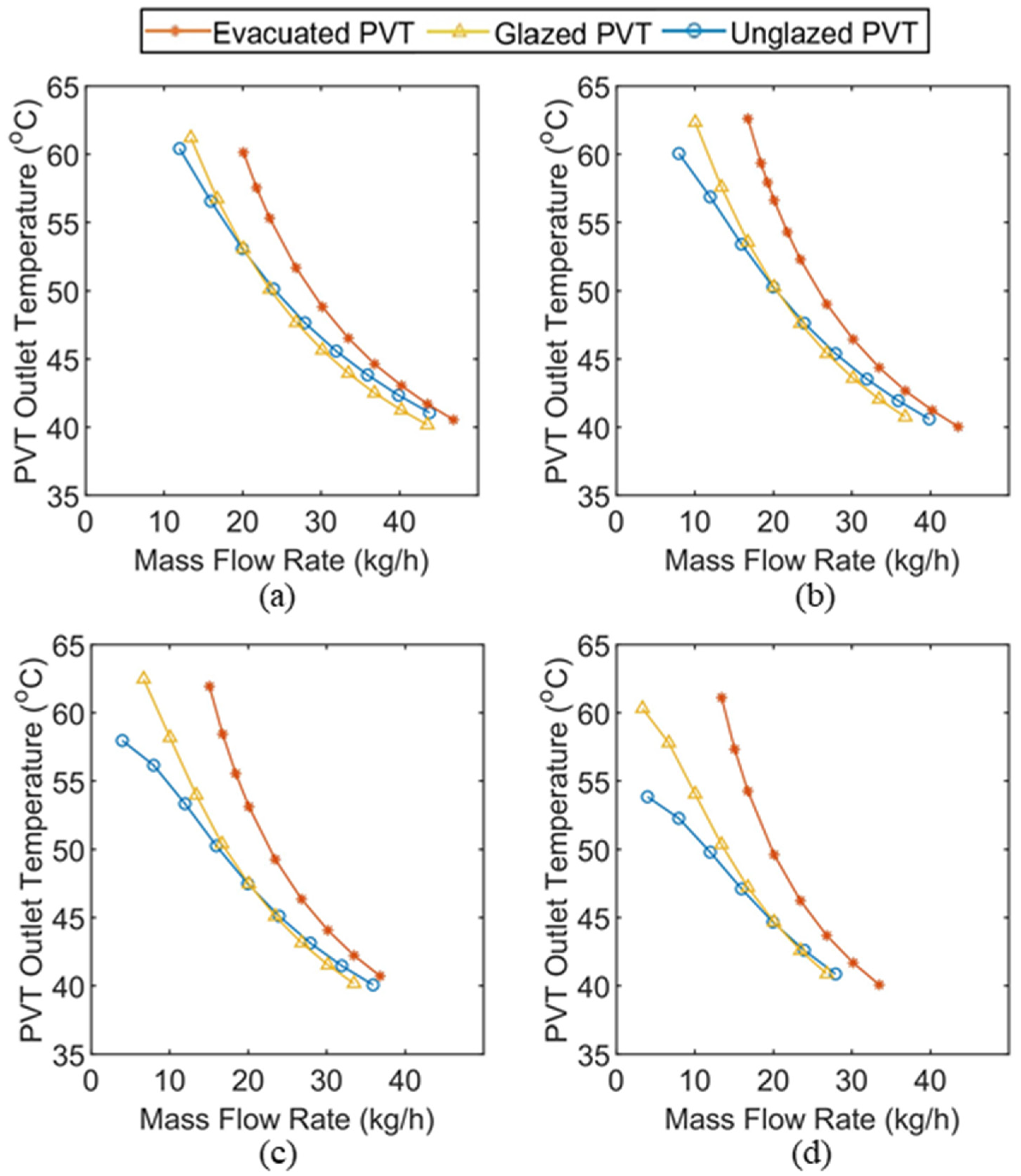
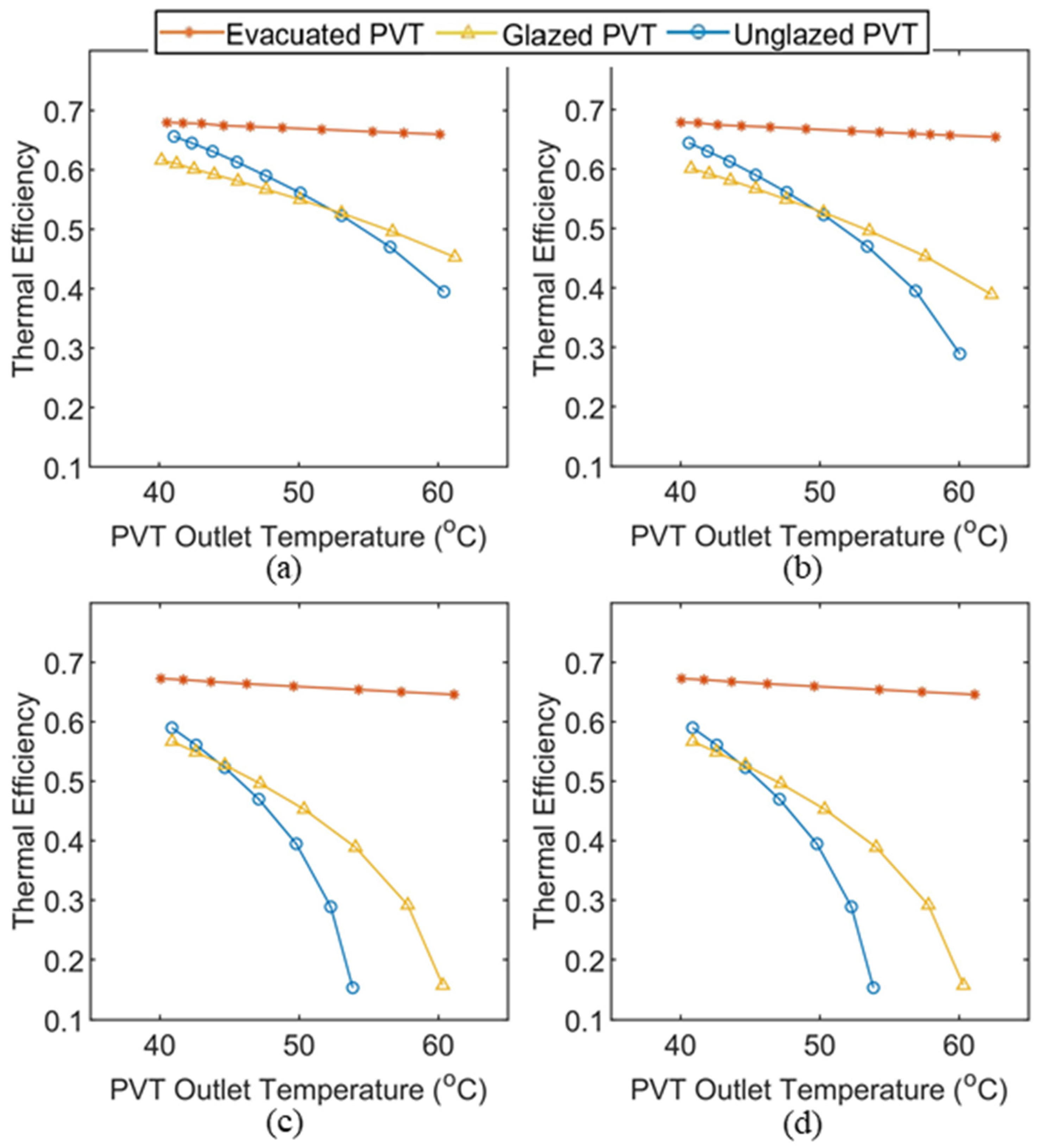
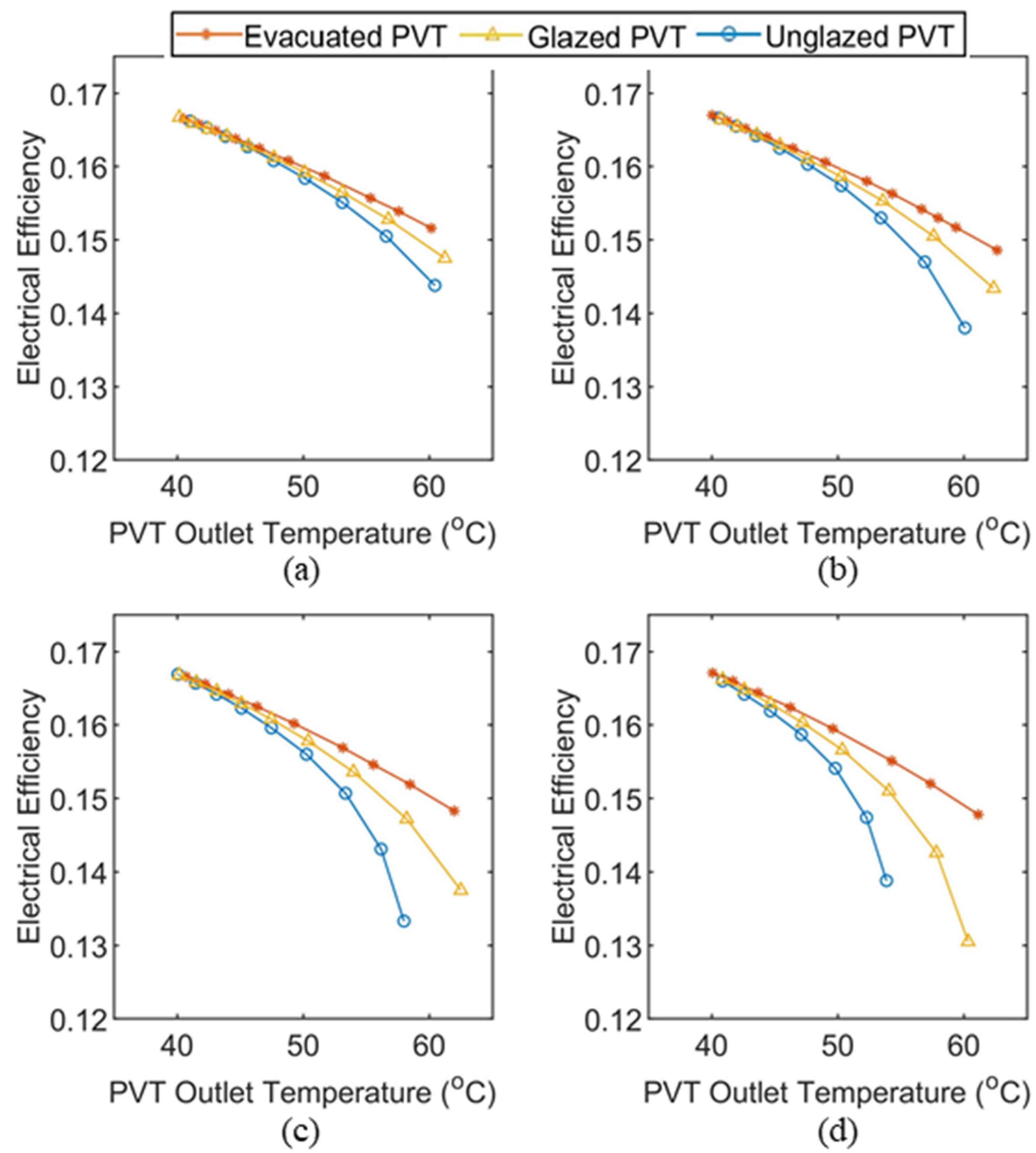
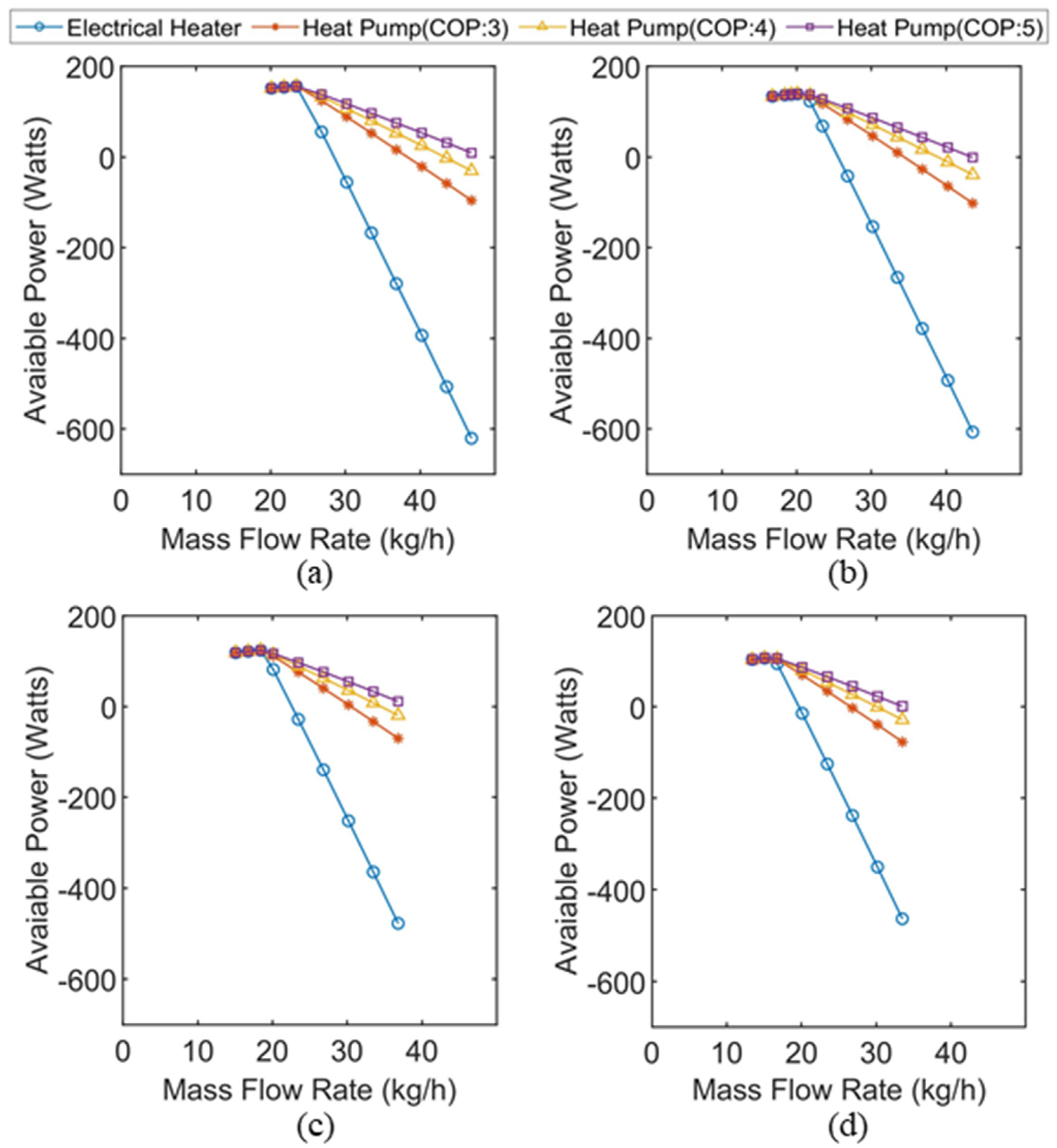
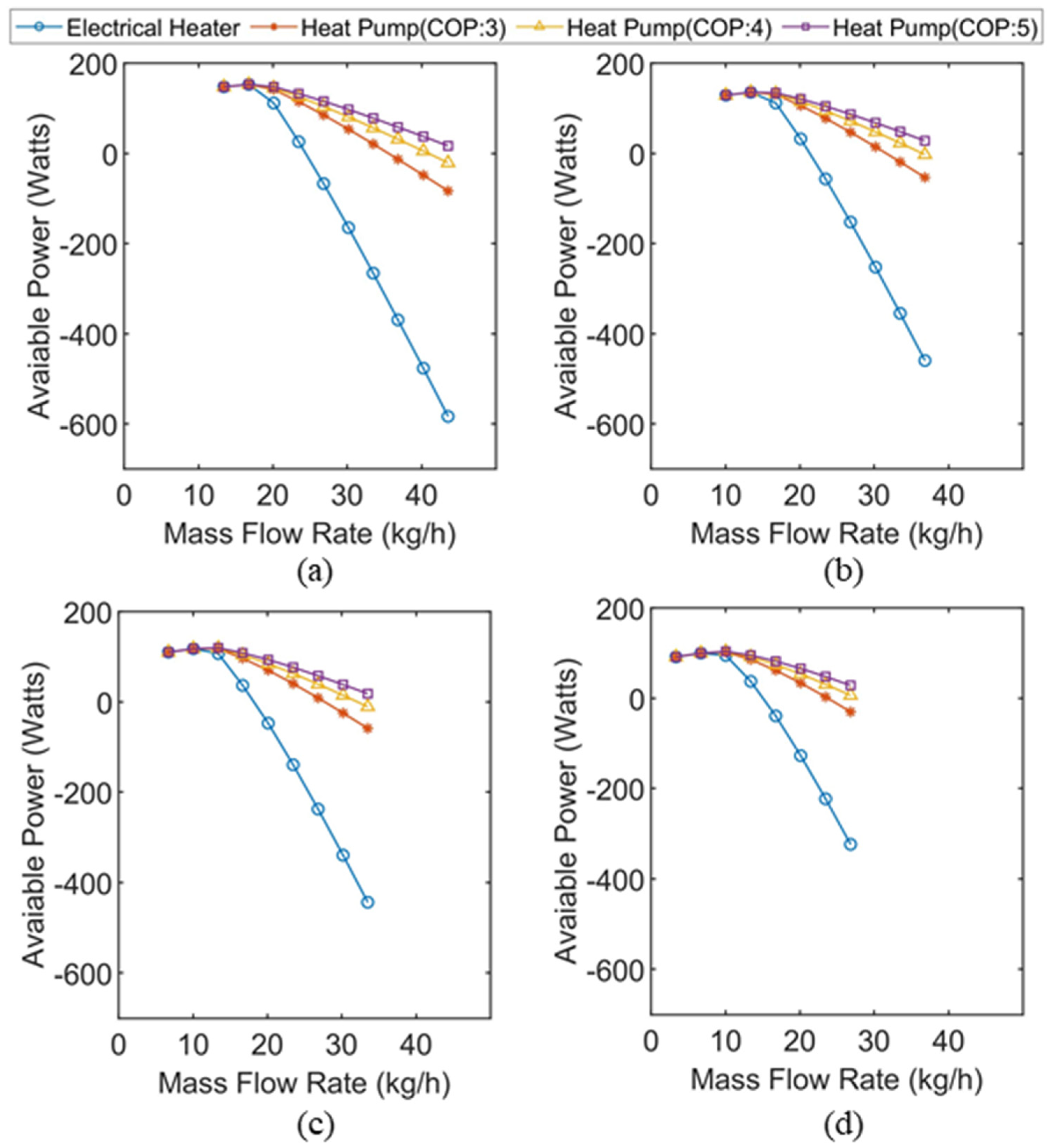
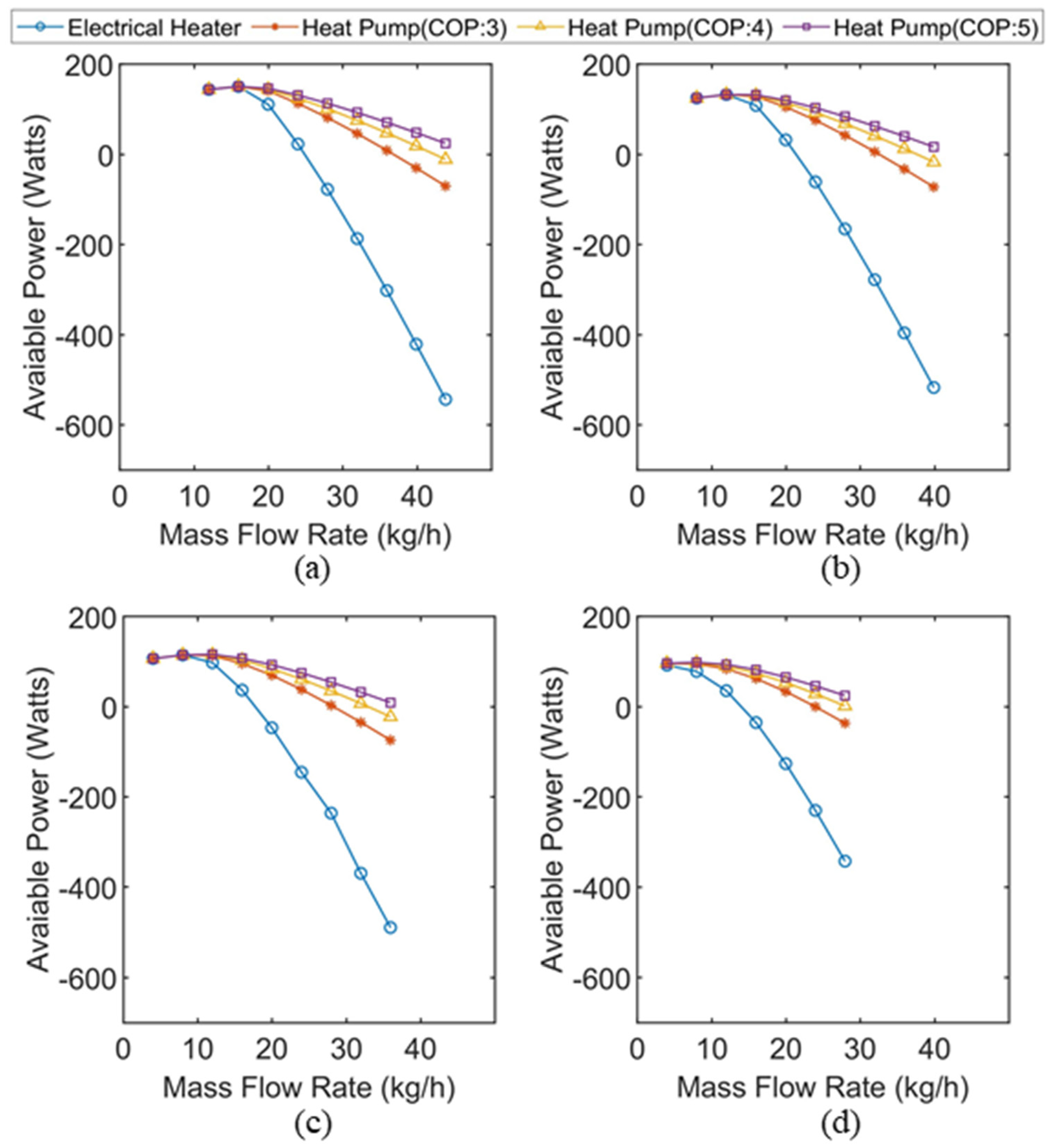
| Material | Thickness (mm) | Density (Kg/m3) | Thermal Conductivity (W/m.K) | Specific Heat (J/kg.K) |
|---|---|---|---|---|
| Glass | 3.0 | 3000 | 2 | 500 |
| EVA | 0.5 | 960 | 0.35 | 2070 |
| Cell | 0.2 | 2330 | 148 | 677 |
| Tedlar | 0.3 | 1200 | 0.2 | 1250 |
| No. of Cells | No. of Nodes | Outlet Temperature (K) |
|---|---|---|
| 781200 | 876609 | 331.24 |
| 390600 | 440319 | 331.54 |
| 143190 | 168756 | 333.19 |
Publisher’s Note: MDPI stays neutral with regard to jurisdictional claims in published maps and institutional affiliations. |
© 2022 by the authors. Licensee MDPI, Basel, Switzerland. This article is an open access article distributed under the terms and conditions of the Creative Commons Attribution (CC BY) license (https://creativecommons.org/licenses/by/4.0/).
Share and Cite
Roshanzadeh, B.; Premer, L.R.; Mohan, G. Developing an Advanced PVT System for Sustainable Domestic Hot Water Supply. Energies 2022, 15, 2346. https://doi.org/10.3390/en15072346
Roshanzadeh B, Premer LR, Mohan G. Developing an Advanced PVT System for Sustainable Domestic Hot Water Supply. Energies. 2022; 15(7):2346. https://doi.org/10.3390/en15072346
Chicago/Turabian StyleRoshanzadeh, Behnam, Levi Reyes Premer, and Gowtham Mohan. 2022. "Developing an Advanced PVT System for Sustainable Domestic Hot Water Supply" Energies 15, no. 7: 2346. https://doi.org/10.3390/en15072346






